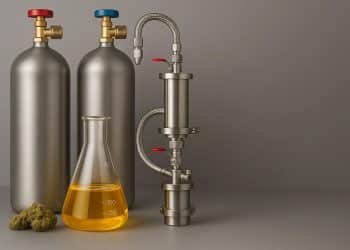Researchers recently reviewed ultrasound assistance for green high-pressure solvent systems like supercritical carbon dioxide (CO2). [1] Ultrasound irradiation presents several benefits:
- Less energy
- Lower solvent use
- Faster process time
- Increased yield
Application of ultrasound to improve extraction relies on the phenomena of cavitation. Cavitation refers to the process of pressure bubbles forming in the fluid that implode. These implosions generate major pressure, heat, and turbulence that help accelerate extraction. Ultrasound waves also swell cells making the cell walls more porous.
Key variables when considering ultrasound include power intensity (W/cm2) and power density (W/cm3). Intensity refers to the amplitude of the waves; low-intensity applications are <1 W/cm2 while high-intensity applications range from 10-1000 W/cm2. Density accounts for the volume of the extraction vessel. Density is particularly important when considering acoustic streams and scalability.
The aforementioned researchers note that “when a liquid is pressurized, the acoustic intensity required to produce cavitation also increases…” High-density solvents have more volatile cavitation conditions once the minimum pressure for cavitation is reached. High surface tension and viscosity also increase the threshold for cavitation. Surfactants reduce surface tension and therefore may be useful in reducing cavitation threshold. The threshold for cavitation of CO2 and water is cited at 5.82 MPa and 20º C [2].
Riera et al [3] tested ultrasound-assisted supercritical CO2 extraction with almond oil from almonds. The transducer was installed in the extractor and extraction conditions set to 28 MPa (280 bar), 55º C, and a flowrate of 55 kg/hr. They applied 50 W of power from the 18 kHz transducer; this increased kinetics by 30% and yield by 20%. [3] Fitting the transducer inside the vessel improves power density (no passing through walls).
In a study on the extraction of “pungent compounds” from ginger, the transducer was fitted externally. [4] The pressure was set to 16 MPa (160 bar), 40º C, an ultrasonic power of 300 W, and an ultrasonic frequency of 20 kHz. The ultrasound application boosted both extraction rate and yield, with “improvements [in yield] up to 30% toward the end of the extraction time.” These researchers also note that “cavitational events could possibly occur through the formation of sub-critical bubbles of gas in the supercritical fluid.” [4]
Using ultrasound with high-pressure solvents requires examination of extraction and ultrasound variables to promote agitation and cavitation. Harnessed properly, ultrasound can improve the botanical extraction process and boost yields.
References
- Vardanega R, et al. Intensification of bioactive compounds extraction from medicinal plants using ultrasonic irradiation. Pharmacogn Rev. 2014 Jul-Dec; 8(16): 88–95. doi: 10.4103/0973-7847.134231. [Impact Factor: 2.135; Times Cited: 46 (Semantic Scholar)]
- Kuijpers MW, van Eck D, Kemmere MF, Keurentjes JT. Cavitation-induced reactions in high-pressure carbon dioxide. Science. 2002;298:1969–71. [Impact Factor: 41.845; Times Cited: 87 (Semantic Scholar)]
- Riera E, et al. Mass transfer enhancement in supercritical fluids extraction by means of power ultrasound. Ultrason Sonochem. 2004;11:241–4. [Impact Factor: 6.513; Times Cited: 177 (Semantic Scholar) ]
- Balachandran S, Kentish SE, Mawson R, Ashokkumar M. Ultrasonic enhancement of the supercritical extraction from ginger. Ultrason Sonochem. 2006;13(6):471-479. doi:10.1016/j.ultsonch.2005.11.006. [Impact Factor: 6.513; Times Cited: 196 (Semantic Scholar)]
Image: Barbara Jackson from Pixabay












